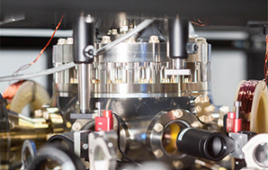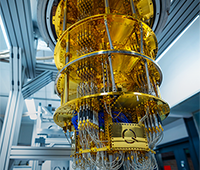 The Energy Department announced $3 million for 10 new projects that will enable private-sector companies to use high-performance computing resources at the department’s national laboratories to tackle major manufacturing challenges. The projects range from improving turbine blades in aircraft engines and cutting heat loss in electronics to reducing waste in paper manufacturing and improving fiberglass production. Led by Lawrence Livermore National Laboratory (LLNL), with Lawrence Berkeley National Laboratory and Oak Ridge National Laboratory as strong partners, the High-Performance Computing for Manufacturing (HPC4Mfg) Program is forging these new partnerships to increase the efficiency of manufacturing processes, accelerate innovation, and improve the quality of clean energy products.
The Energy Department announced $3 million for 10 new projects that will enable private-sector companies to use high-performance computing resources at the department’s national laboratories to tackle major manufacturing challenges. The projects range from improving turbine blades in aircraft engines and cutting heat loss in electronics to reducing waste in paper manufacturing and improving fiberglass production. Led by Lawrence Livermore National Laboratory (LLNL), with Lawrence Berkeley National Laboratory and Oak Ridge National Laboratory as strong partners, the High-Performance Computing for Manufacturing (HPC4Mfg) Program is forging these new partnerships to increase the efficiency of manufacturing processes, accelerate innovation, and improve the quality of clean energy products.
Assistant Secretary for Energy Efficiency and Renewable Energy David Danielson and other U.S. Department of Energy and industry experts discussed the projects February 17, 2016, during an online media presentation highlighting the HPC4Mfg Program and projects.
“Access to supercomputers in the Department of Energy’s labs will provide a resource to American firms inventing and building clean energy technologies right here at home that no international competitor can match,” said Assistant Secretary Danielson. “The HPC4Mfg initiative pairs leading clean energy technology companies with the world-class computing tools and expertise at our national labs to drive down the cost of materials and streamline manufacturing processes. The ultimate goal of their collaboration is to increase our global competitiveness in the race to develop clean energy technology and jobs.”
This effort will also advance President Obama’s National Strategic Computing Initiative, which the President unveiled in July 2015, that calls for public-private partnerships to increase industrial adoption of high-performance computing.
Each of the 10 new Phase I projects have been selected for approximately $300,000 to fund the national labs to partner closely with each chosen company to provide expertise and access to high-performance computing systems aimed at high-impact challenges.
Under the HPC4Mfg program, the 10 selected projects will leverage the national labs’ high-performance computing capabilities to apply modeling, simulation and data analysis to industrial products and processes to lower production costs and shorten the time it takes to bring new clean energy technologies to market. Another overarching objective is to keep the United States at the forefront of innovation by accelerating advanced clean energy technologies and energy-efficient solutions that improve our nation’s economic competiveness in manufacturing. These 10 Phase I projects are aimed at lowering the barrier of entry for industry to use high-performance computing and validate its use in improving manufacturing.
“The Energy Department wants to make sure that the clean energy technologies and efficient manufacturing that defines the next decades is invented and built right here at home,” said David Danielson. “The HPC4Mfg Program couples leading clean energy technology companies with the world-class computing tools and expertise at our national labs to drive down the cost of energy-efficient materials and manufacturing processes, making the U.S. more globally competitive.”
Danielson also announced that AMO is making another $3 million available for qualified industry partners to participate in a new round of HPC4Mfg proposals, to be announced in the coming month.
The selected projects include:
- GLOBALFOUNDRIES will collaborate with LBNL to optimize the design of transistors under a project entitled: “Computation Design and Optimization of Ultra-Low Power Device Architectures.”
- The Lightweight Innovations for Tomorrow Consortium in Michigan will partner with LLNL to develop, implement and validate a defect physics-based model to predict mechanical properties of Al-Li forged alloy, under a project entitled: “Integrated Computational Materials Engineering Tools for Optimizing Strength of Forged Al-Li Turbine Blades for Aircraft Engines.”
- ZoomEssence of Kentucky will partner with LLNL to optimize the design of a new drying method using HPC simulations of dryer physics, under a project entitled: “High Performance Computing Analysis for Energy Reduction of Industry Spray Drying Technology.”
- United Technologies Research Center, located in East Hartford, CT, will partner with ORNL and LLNL to develop and deploy simulation tools that predict the material microstructure during the additive manufacturing process to ensure that critical aircraft parts meet design specifications for strength and fatigue resistance, under a project entitled: “Integrated Predictive Tools for Customizing Microstructure and Material Properties of Additively Manufactured Aerospace Components.”
- Procter & Gamble of Ohio will partner with LLNL to reduce paper pulp in products by 20 percent, which could result in significant cost and energy savings in one of the most energy intensive industries, under a project entitled: “Highly-Scalable Multi-Scale FEA Simulation for Efficient Paper Fiber Structure.”
- General Electric (GE), NY, will partner with ORNL to assist in the local control of melt pool and microstructure in additive manufactured parts, under a project entitled: “Process Map for Tailoring Microstructure in Laser Powder Bed Fusion Manufacturing (LPBFAM) Process.”
- In a separate project, GE will partner with ORNL and LLNL to improve the efficiency and component life of aircraft engines through design optimization, under a project entitled: “Massively Parallel Multi-Physics Multi-Scale Large Eddy Simulations of a Fully Integrated Aircraft Engine Combustor and High Pressure Vane.”
- PPG Industries of North Carolina will partner with LLNL to model thermo-mechanical stresses involved in forming and solidifying glass fibers to understand fracture-failures mechanisms to significantly reduce waste, under a project entitled: “Numerical Simulation of Fiber Glass Drawing Process via a Multiple-Tip Bushing.”
- In a separate project, PPG Industries of Pennsylvania will partner with LLNL to develop a reduced computational fluid dynamics (CFD) model of a glass furnace to make informed line adjustments in hours in near real-time, under the title: “Development of Reduced Glass Furnace Model to Optimize Process Operation.”
- The AweSim program at the Ohio Supercomputer Center (OSC) and the Edison Welding Institute (EWI) will partner with ORNL to deploy cloud-based advanced welding simulation tool for broad industry use, under a project entitled: “Weld Predictor App.”
LLNL established HPC4Mfg in March 2015, launched four “seedling” projects, and put in place a formal governance model. Lawrence Berkeley and Oak Ridge National Laboratories joined in September 2015 to support the Phase I solicitation, which was originally announced by Danielson at the American Energy and Manufacturing Competitiveness Summit in Washington, D.C. that month.
The Advanced Manufacturing Office within the Department’s Office of Energy Efficiency and Renewable Energy created and funds this program. The HPC4Mfg projects also support the Energy Department’s broader Clean Energy Manufacturing Initiative to increase U.S. competitiveness through manufacturing clean energy technologies, boosting energy productivity and leveraging low-cost domestic energy resources and feedstocks.



